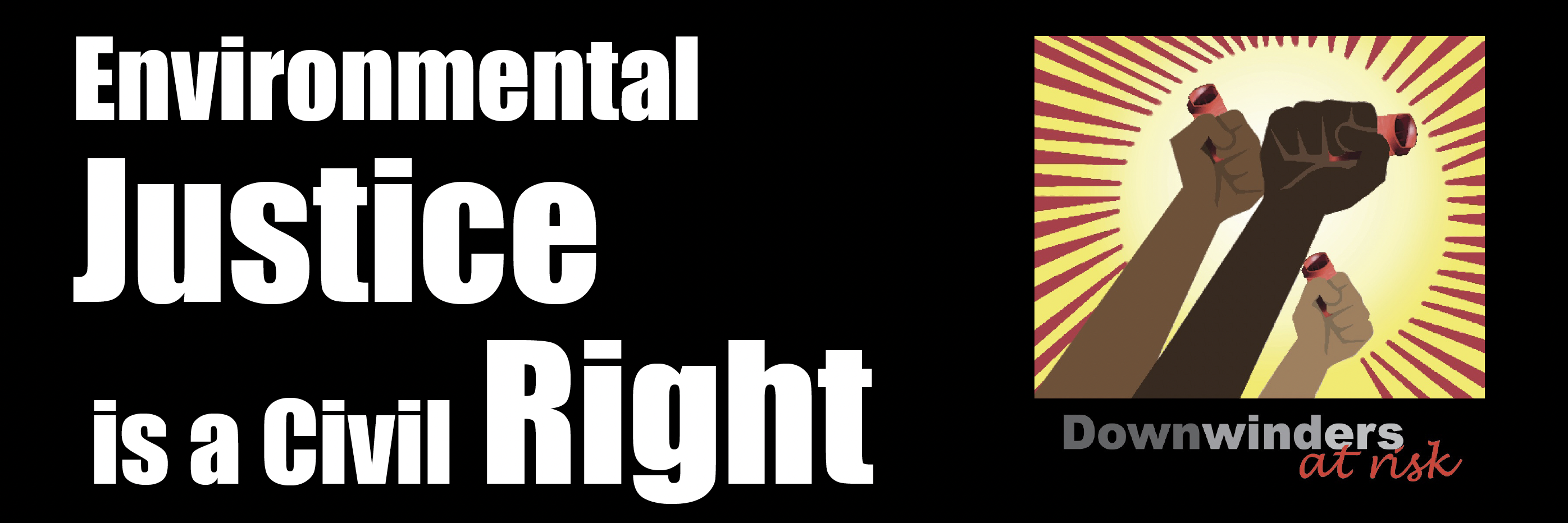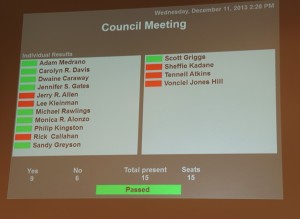Fracking
Can a Council Whose Majority Voted for the Trinity East Permits Now be Expected to Defend the City’s Denial?
 As you might have heard by now, forlorn natural gas operator Trinity East has sued the City of Dallas for denying the three permits it was seeking to drill along the Trinity River in Northwest Dallas by the Irving border. Claiming breach of contract and even fraud, the company is saying it's owed millions of dollars above and beyond the $19 million it spent on leases for the three sites.
As you might have heard by now, forlorn natural gas operator Trinity East has sued the City of Dallas for denying the three permits it was seeking to drill along the Trinity River in Northwest Dallas by the Irving border. Claiming breach of contract and even fraud, the company is saying it's owed millions of dollars above and beyond the $19 million it spent on leases for the three sites.
Anyone who's seen the filing knows this is a lawsuit with no legs. Yes, Trinity East leased the land, but guarantees about permits being awarded were not part of the deal. Those can't be bought so blatantly. Even Mary Suhm's secret memo un-earthed last February by the Dallas Observer made it clear that her assistance was not a guarantee and "not a legally binding agreement." The leases were one thing. The permits another. Trinity East thought it had the permits in hand when Suhm signed her memo. So did Suhm.
That's why citizens were told in 2012 that Trinity East permits were a "done deal" by sources in City Hall, including Mayor Rawlings, who seems to have known about the Suhm memo before the public did. There was just no way those permits were going to be denied. Suhm and the Mayor were not going to let that happen. That's why they called for the hearing and permit vote two days before Christmas. They thought no one would show and they could wrap it up. So it was a big surprise when the City Plan Commission voted to deny the TE permits. Undeterred, there was suddenly a call for an unprecedented, second "reconsideration vote" by the Plan Commission by the Mayor's representative on the same permits. But Trinity East lost that fight too, by a wider margin, in January of 2013. This time without any public hearing.
When the CPC denial came to the City Council in August of 2013, charter rules demanded it must be overridden by a super majority of 12. The vote to overturn the CPC's denial was 9 to 6, leaving the denial in place, but showing a majority of the current council in favor of granting the permits.
Then the strategy turned to adapting the new drilling ordinance to fit the Trinity East permits. If they couldn't make it through the front door, they could go in the back way. And so City legal staff tried to manipulate the City Plan Commission into carving out exceptions in the new draft ordinance that would allow that. Instead of a 1500-foot setback, they urged 1000 feet with a variance back to 500 feet. That would allow all Trinity East sites. Then they tried to ease the rules on park drilling, and even succeeded to some extent, softening a ban on surface drilling in parks that was part of the old ordinance.
Only Dallas residents working overtime and applying more scrutiny saved the day and got Plan Commission support for a new ordinance that did finally shut the door on all three Trinity East permits. And of course, that's when Trinity East, aided by the entire gas industry, decided to sue.
So you now have the weird situation where the same City Hall that was trying so desperately to win those permits for Trinity East is now being sued by the company for not being conspiratorial enough to subvert the public process. Yesterday, the city issued an statement saying the company's lawsuit lacked merit and, "The city will vigorously defend its right to exercise its regulatory powers to protect public health and safety as well as the environment."
But here's the thing. Since a clear majority of current Dallas City Council members voted for the permits, how much will power is there among this same group to now defend a position they didn't take? And since it was often the Dallas City Attorney's office leading the charge to manipulate the system on Trinity East's behalf, how well do you trust that same crew to "vigorously defend" the outcome they tried so hard to prevent?
Three are some legal principles involving the city's right to control its own zoning decisions which could motivate the city and/or the Texas Municipal League into such a defense. But you have to wonder how much heart they really have for a fight, of which right up until the last vote, they were on the same side as the company now suing them.
To make sure the City doesn't settle with Trinity East, citizens are going to have to persuade the three council members who voted with them for the new ordinance, but against them on the Trinity East permits to change their minds – Jennifer Staubach-Gates, Dwaine Carrawy and Mayor Ralwings.
That won't be easy. Rawlings was making the "I told you so" rounds in the media yesterday. The first sign that they might be serious about defending themselves is whether they'll hire an outside law firm with municipal law experience to represent them. If they put the same people in the City Attorney's office who were working in concert with Trinity to win those permits in charge of this fight, we're doomed. If they hire a competent firm with a reputation for toughness, you'll know they think there might be some points of law worth going to court for.
Longer term, it once again puts a spotlight n the need to elect additional allies of the six council members who've been reliable allies to citizens on this issue. This coming Dallas municipal election cycle in 2015 will see almost half the council seats up for grabs as incumbents are term-limited out. Stay tuned.
Between Now and Friday: Tell Them What They Can Do With Their Smog
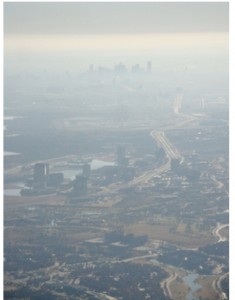 Frustrated that Rick Perry's Texas Commission on Environmental Quality isn't doing enough to end DFW's chronic smog problem, the local "Council Of Governments" has issued a "Request for Information" asking for the public's help in suggesting ways to reduce ozone pollution in North Texas.
Frustrated that Rick Perry's Texas Commission on Environmental Quality isn't doing enough to end DFW's chronic smog problem, the local "Council Of Governments" has issued a "Request for Information" asking for the public's help in suggesting ways to reduce ozone pollution in North Texas.
Please use our Click N' Send E-mail form to make sure they get the message that the public wants:
1) State-of-the-Art pollution controls on huge "point sources" of pollution like the Midlothian cement kilns and East Texas power plants.
2) New pollution control equipment and strategies to reduce the air pollution from the thousands of natural gas facilities mining the Barnett Shale.
3) Inclusion of all trucks and off-road vehicles in the state's vehicle maintenance and inspection program.
You can also add strategies or ideas of your own as well. Just click here, fill out the e-mail and send it in to be counted.
It takes as little as 30 seconds.
BUT YOU ONLY HAVE UNTIL 5 pm FRIDAY, VALENTINE'S DAY.
______________________________________________________________
Rick Perry's TCEQ is so discredited on the matter of DFW smog, local officials usually working in concert with the state agency are now looking elsewhere for help.
Ever since DFW was required to write and submit new clean air plans, The North Central Texas Council of Governments has been the local vehicle used by the state to funnel information, concern, and ideas back and forth.
It was never easy to get Austin's attention or convince the Powers That Be of the need to take bigger clean air measures. It took a decade for Downwinders to get the State to admit that the Midlothian cement plants had a huge impact on local air quality before they were the targets of new controls.
But ever since Rick Perry began running for President in 2010, it's been impossible for Austin toget serious about any DFW clean air plan. For the past four years, TCEQ has claimed that it can reduce air pollution enough by doing nothing.
That strategy has been a dismal failure. New car buying in the middle of the worst economic downturn since the 1930's was the TCEQ clean air plan in 2011. Austin promised that if we just sat back, we'd have the lowest smog levels ever recorded. Instead we had worse air pollution levels than we did five years ago.
This time round, TCEQ is saying a new EPA-mandated low-sulfur gasoline mix in 2017 will be the region's savior for the new clean air plan that's supposed to be successful in reaching the new federal ozone standard of 75 parts per billion in 2018. We're at 87 ppm now – still in violation of the old 1997 standard.
Just watch this new fuel being added to cars and see the ozone numbers drop, TCEQ is saying. No need to put controls on gas facilities, or cement kilns, or power plants. Nothing that would give Rick Perry's opponents on the Right any opportunity to claim he was "anti-bidness."
Even the Council of Governments isn't buying it.
That's why, in their own bureaucratic fashion, this Request for Information that the COG has issued is it's own middle-of-the-road middle finger to TCEQ.
Usually, it would be the state facilitating a discussion of new air pollution control strategies, but since it's obviously not interested, the COG has decided to go its own way. That's how bad things have gotten in Austin – even their most reliable allies in DFW can no longer take them seriously.
It's not clear what will happen to the list of control measures that the Council of Governments is assembling. Some might receive some more official attention, but locals have no authority to write or override Austin's decisions. TCEQ is the only entity that's authorized to submit a new clean air plan to EPA by the June 2015 deadline.
But there are ways to use the useless clean air plans that Austin is submitting. Downwinders' own green cement campaign is a great example.
In 2007, we successfully inserted a voluntary air pollution control strategy into the TCEQ plan revolving around the purchasing of cement from newer cleaner "dry" kilns by local North Texas governments. We then took that "green cement" procurement option and went to Dallas to pass the nation's first green cement ordinance. Then Fort Worth passed it. Then Plano. Then Arlington. Then Denton. Then Dallas County. Then Tarrant County.
Within two years, we had established a de facto moratorium on dirtier "wet kiln" cement within at least a dozen municipal and counties. Combined with federal rule changes, we were able to get all Midlothian wet kilns closed. The last one is being be converted to a dry kiln this year. All while Rick Perry was governor.
The same thing could happen with a good "off-sets" policy for gas facilities if a local city of county could pass a template ordinance showing the way. Currently, most of the gas industry is exempt from being required to "off-set" their air pollution in smoggy "non-attainment" areas like other large industries in DFW. Take away this exemption and you'll see a swift decrease in gas industry air pollution.
It's these kinds of strategies that don't depend on action from Austin that offer the greatest potential for progress this time around.
TCEQ has never written a successful clean air plan for North Texas, and it's not going to start now. But citizens themselves can take their lungs' fate into their own hands and begin to build a system of local measures that can make breathing easier.
______________________________________________________________
CALENDAR AND STATUS REPORT OF DFW'S NEWEST CLEAN AIR PLAN
Reach a 3-year rolling average of no more than 75 ppm of ozone at all 18 DFW area air monitors.
Why Downwinders is involved in the Azle Earthquake Fight
 Downwinders at Risk's Jim Schermbeck was one of several speakers at the public organizing meeting on January 13th in Azle, just northwest of Ft. Worth, that saw the creation of a local citizens group to campaign to end the "human-induced" earthquakes plaguing the area for the past several months.
Downwinders at Risk's Jim Schermbeck was one of several speakers at the public organizing meeting on January 13th in Azle, just northwest of Ft. Worth, that saw the creation of a local citizens group to campaign to end the "human-induced" earthquakes plaguing the area for the past several months.
On Tuesday, he'll climb aboard a bus with Azle area residents and go to Austin to speak before the Texas Railroad Commission about the need to cease operations at local fracking waste injection wells until a Unites States Geological Service study on problem in completed in April.
Why is a group whose stated mission is protecting the DFW airshed getting involved with a fight over injections wells and earthquakes?
1. We were asked to. There just aren't that many groups in Texas that employ someone who knows how to parachute into a community and start an effective campaign from scratch. Downwinders is one of them. When we're asked to help a community we haven't been involved in before, as we were in Frisco, and as we are now in Azle, we think about our own past and the lack of any professional resources on the scene in the early 1990's during our fight with the Midlothian cement kilns. If we can be of some help in assisting people who legitimately need it, we usually don't turn them down.
2. Injections wells can be significant sources of air pollution. These facilities can dispose of 100 to 200 million gallons or more of waste every year. Besides fugitive emissions for unloading and storage, some injection wells also have outdoor pools of waste that systematically evaporate pollutants into the air. Injection wells are known to contribute to air quality problems on the ground similar to those experienced by original Downwinders living near the Midlothian cement kilns when they were burning hazardous waste. It turns out there are downwinders surrounding injection wells too. These well emissions are not only a toxic threat to residents living in the immediate vicinity, but they also contribute to regional smog problems too.
3. A win in Azle could led to saner restrictions on locating injection wells. It looks like the recent "swarm" of earthquakes around Azle are centered between two active injection wells. Why are these wells causing problems but others aren't? And why are injection wells being placed in densely populated areas near lots of water wells and infrastructure? DFW Airport saw earthquakes from their injection well and it got closed. Azle residents just want the same respect as American Airlines jets. Are there places in Texas where injections wells shouldn't be located? Yes. Like airports and places where people live near-by. Is it possible to use the Azle fight to better articulate that, regionally or even statewide? Yes. And that would be a good thing.
4. Azle represents an opportunity to organize and win deep behind enemy lines. Azle is in the heart of the Barnett Shale. It's already surrounded by wells and pipelines and compressors, and yet area residents know the shaking that's disrupting their lives is directly linked to fracking itself. This is a revolt of the already-gassed masses, something the western part of the Metromess hasn't seen. It's also true that Azle is prime tea-party GOP territory. Making alliances there helps give lie to the myth that environmental health is only something Democrats and tree-huggers are concerned about. Azle residents can't be easily dismissed as Greenpeace types. You can already see the worry from elected officials over the rise of these new critics. Railroad Commission special meetings. The hiring of a new state seismologist. A new legislative committee on quakes. All in less than a month. This ain't Austin. It's not even Dallas.
That's why we're getting on the bus come Tuesday.
It Happened Last Night
 Azle area families are proud to announce the birth of their new grassroots group, and movement, born last night around 8:30 pm, CST.
Azle area families are proud to announce the birth of their new grassroots group, and movement, born last night around 8:30 pm, CST.
It's so new, the 300 or so parents haven't had a chance to name it yet. But it does have a mission: challenging the Barnett Shale status quo.
There's an air of mystery surrounding how these things happen. Many people don't want to be in the room when it actually occurs. Many get nervous. Sometimes it gets messy.
But it's really quite a simple procedure and last night the delivery room was primed for quick and decisive action by two earthquakes in the last 24 hours. No prolonged labor this time. When the call went out to fill the ranks of a local steering committee, bodies shot up out of chairs and spoke their names into the mic for posterity. Male and female, booted and sneakered, grandparents and their grandchildren, Black, Anglo and Hispanic. At the end, approximately 20 volunteers stood in front of the crowd receiving a thankful ovation from their peers.
There are few more poignant moments you can witness in American democracy than the birth of real citizenship.
The newcomer will be taking its first baby steps very soon – at least one bus is being chartered to go to the next Railroad Commission meeting in Austin this next Tuesday, January 21st, and speak to the need of immediate help versus the delay and more study approach of the state. The meeting begins at 9:30am. Details are being worked out now, but the parents say you don't have to be from the Azle area to join the Austin protest. It takes a region to raise a ruckus.
Congratulations to the parents. May their offspring grow up to be strong and smart, and know how to do its job in the shortest amount of time possible. Here's some sample news coverage of the birth:
“We don’t really know, 8,000 feet below, where the waste goes”
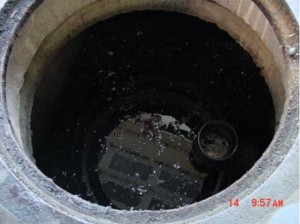 That's Texas Supreme Court Justice Paul Green blurting out an unfortunate truth even as he was trying to defend an injection well that's being sued for trespassing into groundwater under an adjacent rice farm in Liberty County near the Texas gulf coast.
That's Texas Supreme Court Justice Paul Green blurting out an unfortunate truth even as he was trying to defend an injection well that's being sued for trespassing into groundwater under an adjacent rice farm in Liberty County near the Texas gulf coast.
The Texas Tribune's Jim Malewitz has the scoop on a so far mostly over-loooked case that could set some important precedents about land rights and underground contamination. How do we know? Because the oil and gas industry told Maelwitz:
In 1997, Environmental Processing Services finished drilling an injection well about 400 feet from FPL Farming’s land, which the farm contested early on. Since then, the company has injected more than 100 million gallons of wastewater, gradually expanding the well's underground footprint.
The well in question is labeled Class I and used for nonhazardous industrial waste. It is not one of the 50,000 Class II wells that drillers typically use. But lower-court opinions have drawn no distinction between the wells. That has stirred concerns among oil and gas producers that a ruling in the farm’s favor would complicate efforts to dispose of drilling waste, thereby stalling production.
“Because the ability to produce oil and gas is inextricably tied to the availability of injection wells,” the Texas Oil and Gas Association says in a brief, “a new common law cause of action that threatens operation of injection wells likely threatens oil and gas production."
As Malewitz points out, the case raises the questions of "just how far below the earth’s surface do property lines extend? And can someone trespass on another’s property — more than a mile underground?"
Since it's close to the coast, the farm's groundwater is too salty to drink now but the farm's lawyers argue that desalinization technology could render the water useful. They say regardless of its salinity, it's a resource and a piece of private property that's being poisoned by the well's waste stream that includes the flammable liquid acetone.
Now you may think the waste well operators, "Environmental Processing Services," would deny any contamination of the farm's water as a first line of defense. But as it turns out everyone in industry and the regulatory agencies believes that after you've pumped 100 million gallons of industrial waste down a hole 800 feet deep, it will tend to "migrate" outside the fence line of the well itself. So what kind of arguments are EPS's lawyers that the Texas Supreme Court is finding so persuasive?
1) Our waste may be migrating, but since we can't go down there and check, you really can't conclusively prove that it's under the farm…yet. All you have is an industry-government model that everybody uses that says it has.
2) The water is already polluted with too much salt, so there's no way you can pollute already polluted water. So there.
3) Even if it is polluted by our waste, maybe that same desalinization technology the farm wants to use to make the water useable will also be able to filter our industrial waste out if it.
Of course, these equivocating arguments in court by lawyers are a far, far cry from the air-tight assurances Texans get from the industry spokespeople or slavishly pro-industry elected officials, who GUAR-AN-TEE that no fracking waste injection well could ever contaminate groundwater.
Really. You should go read the article. The lawyers are making lots of money on this one. No timeline for a ruling.
Was Azle the Barnett Shale’s “Walter Cronkite Moment?”
 When Walter Cronkite announced that America was losing the war in Vietnam, LBJ knew he'd lost Middle-America.
When Walter Cronkite announced that America was losing the war in Vietnam, LBJ knew he'd lost Middle-America.
When the gas industry is losing the editorial board of the Fort Worth Star-Telegram, is it a sign it's losing the PR war in the Barnett Shale?
While Sunday's editorial in the Star-Telegram, titled "Texas Railroad Commission can’t just tippy-toe around quakes" falls far short of a wholesale condemnation of urban injection well operations, it does castigate the Railroad Commission for being promoters of fracking while also being assigned to regulate it on behalf of the public good, and faults it for failing to provide any new facts to the debate at its disastrous public meeting last week in Azle.
Is the three-member commission doing anything to separate facts from speculation and theories?
“In addition to taking the residents’ comments into serious consideration, Commissioner Porter has been in communication with the state geologist in regards to a potential study by the Bureau of Economic Geology,” Porter’s news release said. “Railroad Commission staff is also participating in a work group formed by the Environmental Protection Agency, which includes representatives from the United States Geological Survey and other state regulatory agencies.”
There’s “serious consideration,” a “potential study” and a “work group.” Sounds like tippy-toeing.
In fact, there is a considerable amount of science linking disposal wells, which push millions of gallons of drilling waste into rock formations deep under ground, with “induced” earthquakes.
A report posted in July described one study by USGS scientists. The results were also published in the journal Science.
The rate of quakes increased to about 100 a year in the central and eastern U.S. in the three-year period from 2010 through 2012, up from an average 21 a year from 1967-2000, the study showed. The increase coincided with a rapid increase in oil and gas drilling using hydraulic fracturing, which leaves large amounts of waste water for disposal.
In many ways, the developments in Azle last week represent a bigger threat to the industry than residents' December victory in Dallas over a more protective gas drilling ordinance. It's deep in the heart of the urban Shale instead of being at its edge. It's a spontaneous grassroots revolt led by people who probably voted for Ted Cruz instead of Paul Sadler in 2012. Its participants have lived with fracking for almost a decade now instead of fighting off an invasion as in Dallas. These are folks who are more likely to carrying a concealed weapon than a Sierra Club membership.
It's also true that both industry and government have been caught off-guard by the issue of injection-well earthquakes and are unable to bat down the arguments the way they can with harms that take more time, and have more subtle causal links, like cancer. Empirical evidence makes the case pretty plain, as the Star-Telegram editorial admits. Denials by industry in the midst of earthquake "swarms" centered on injection well locations seem like the environmental equivalent of a reassuring "Baghdad Bob" show while the bombs are falling in the background.
Do the circumstances taking place in the western part of the Metromess represent a new front on the fracking fight in North Texas, or just a momentary rise in tensions that will be gone by the Spring? A lot depends on whether the pace of earthquakes that gave rise to the Azle meeting keep occurring. Thirty of them have been recorded since November alone and if they keep showing up at that rate, there'll be little need of community organizing meetings to get people motivated to do something. The question is what that something is.
A prohibition on injection wells within Standard Metropolitan Areas? Within certain population densities? Within proximity of water wells and infrastructure? A moratorium on any new wells anywhere? Is there and answer that can help the people in Azle and maybe others in the Shale at the same time?
Time will tell whether last week's meeting is a real turning point for facts on the ground, but it's already clear that it marked a milestone in terms of perception. And as we're often fond of saying here at Downwinders, perception is everything.
Follow-Up Study Confirms Lower Birth Weight Babies Around Fracking Sites
 A 2012 study by a Cornell graduate student Elaine Hill that found a 25% increase in low-birth weight babies within 1.5 miles (7920 feet) of a gas fracking sites in Pennsylvania got a boost from a follow-up study previewed over this last weekend at a conference in Philadelphia.
A 2012 study by a Cornell graduate student Elaine Hill that found a 25% increase in low-birth weight babies within 1.5 miles (7920 feet) of a gas fracking sites in Pennsylvania got a boost from a follow-up study previewed over this last weekend at a conference in Philadelphia.
Janet Currie of Princeton University, Katherine Meckel of Columbia University, and John Deutch and Michael Greenstone of the Massachusetts Institute of Technology also looked at Pennsylvania birth records and found the risk of low-weight births increased by 50% within 2. 5 kilometers (8125 feet) of a fracking site. That's over 7 times the distance of the recent 1500 foot buffer zone between homes and drilling pads passed by the City of Dallas last month.
This rate was constant for both households with their own water wells and municipal water system users, seemingly ruling out water contamination as a cause. Air, noise and light pollution are now the suspected culprits.
This second study was specifically designed to address critics of Hill's previous work:
"….they built on the work of Elaine Hill, a PhD student at Cornell University who sparked controversy in 2012 with a study showing that infants born near fracked gas wells had more health problems than infants born near sites that had merely been permitted for fracking. One criticism of Hill's study was that fracking activity might change the demography of an area, attracting more mothers who are likely to give birth to infants with health problem.
The new research addresses such concerns by following a constant group of mothers who had children both before and after the onset of fracking, and by controlling for geographical differences in mothers' initial health characteristics. It seeks to achieve the rigor of a controlled experiment by focusing on mothers who, due to their locations and the dates of their pregnancies, were effectively selected at random to be exposed to fracking.
The study is expected to be accepted for publication sometime this Spring after being peer-reviewed.
Merry Xmas and Have a Less Poisonous New Year
Coming to A Cement Plant Near You? Burning Fracking Fluid
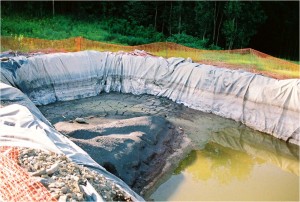 A Canadian LaFarge Cement plant wants to start using fracking fluid to replace fresh water it uses in its manufacturing process.
A Canadian LaFarge Cement plant wants to start using fracking fluid to replace fresh water it uses in its manufacturing process.
The company's Brookfield plant in Nova Scotia is an ancient "wet kiln" that uses approximately 35 million liters of water from a near-by lake to produce cement. Fracking fluid that has been run through a reverse osmosis filtering process would be used as a parital substitute for this fresh water.
According to the local newspaper account, a LaFarge PR spokesman is quoted as saying “It’s safe enough to drink. The contaminants have been removed and the recycled waste water exceeds government guidelines to be released in the environment.”
But funny thing. Despute that assurance of safety, when the company ran a full page ad announcing its plans to use waste water, it forgot to mention that it was waste fracking fluid. Maybe because there's a moratorium on fracking in the Province while a review of its safety and public health impacts are investigated.
Local municipal Council Member Doug MacInnes said he spoke to the LaFarge plant manager about the ad.“He explained to me that it was worded that way so that it wouldn’t get the public upset." According to the LaFarge manager, "I think there is a negative connotation with fracking."
So where is the waste fracking fluid coming from? From two local holding ponds that have been containing the leftovers of three wells way back in 2007 and 2008. About 14 million litres of fresh water was used. When this water was regurgitated by the wells it was poured into the ponds. Many observers believe that although this first step is only a pilot test, LaFarge wants to begin importing fracking fluid from Canada's large oil and gas plays.
When it was burning hazardous wastes in its own wet kilns in Midlothian from 1986 to 2008, TXI Cement also charged companies for disposing of their industrial waste waters, which often contained Volatile Organic Compounds (VOCs), heavy metals, chlorine and other contaminants. Back then, it was called "recycling" and was defended by TXI as a way to reduce fresh water use, and costs. TXI used the "Long, Hot and Good For America" argument it always used to defend the burning of waste – that the high temperatures of the kiln destroy all the bad stuff. Only that's not true. Metals don't burn. Chlorine doesn't burn. And Dioxin can actually be created when plastics are burned.
And there was another problem unique to the disposal of wastewater. The contaminants, especially the VOCs, were being lost to the atmosphere long before the water reached the plant's kilns with their 2500 degree temperatures – the rising heat stripped the pollutants out of the water and sent them up the stacks, causing an increase in pollution. For these reasons, EPA forced TXI to quit using industrial wastewater as a substitute for fresh water even before the wet kilns shut down permanently in 2008 and waste-burning was halted.
With fracking waste water, you get all these kinds of pollutants plus the added threat of radioactivity, of which there is no mention in any of the coverage about the LaFarge proposal. "Natural radioactive elements" as well as ones used in the drilling process have been known to contaminate fracking waste. Reverse osmosis won't be able to fix that.
We've written about idea of oil and gas fracking fluid flowing downhill to the cement plant industry – the least regulated option – for disposal, most recently when it came up in Saudi Arabia. Now it's jumped the pond and has landed in North America. How long do you think it'll be before you see a cement plant near or in a US shale play that will propose the same thing?
One of the practical concerns of citizens over the plans of the LaFarge plant is the effect corrosive fracking fluid that's full of salt has on an industrial process dependent until now on fresh water.
The local Colchester County Council. is planning to send a letter of concern to Lafarge, the minister of Environment, and the local Department of Environment office. Last summer, council rewrote its sewage use bylaw and rejected an application by a local firm to dispose of treated frack waste through the municipal sewer system because of potential dangers to the environment. That same firm is the one that says it will filter the fracking fluid before sending it to LaFarge.
Dallas Council Passes 1500 Foot Setback and Rest of Draft Ordinance
 It was rumored to be a done deal as of last week. Today it actually is.
It was rumored to be a done deal as of last week. Today it actually is.
By a vote of 9 to 6, the Dallas City Council voted to endorse the new gas ordinance drafted by its City Plan Commission, including its 1500-foot setback requirement for wells and compressor stations.
The only change to the Commission recommendations came in a procedural tweak that now requires six votes to stop a variance being rolled back to a minimum of 1000 feet instead of four.
Oak Cliff Council Member Scott Griggs made the motion to approve the Plan Commission recommendations. Before his motion could be voted on however, East Dallas Council Member Sheffie Kadane made a substitute motion to reduce the required setback to 500 feet. This was the stark choice that faced the Council.
They chose wisely. 1500 feet matches the most protective buffer zone current restrictions in the Barnett Shale. It's more than twice as far as the 600 foot setback on the books in Fort Worth. Even the new Dallas minimum of 1000 feet is 400 more than Forth Worth's maximum. Much of todays' public hearing testimony touched on health effects felt by Shale residents who had lived from 300 to 1200 feet from wells.
Along with the defeat of the Trinity East permits earlier in the year, passage of the Dallas ordinance represents the biggest recent victories of urban fracking opponents in the Barnett Shale.
Not only is there a brand new "Dallas Model" to compete and contrast with the "Fort Worth Model" that industry loves to tout, but there's a brand new feeling that environmentalists actually have some clout in city politics in Dallas for the first time.
Congratulations to all those who worked so hard to see this result happen against so many obstacles over the last four years. Well done.
